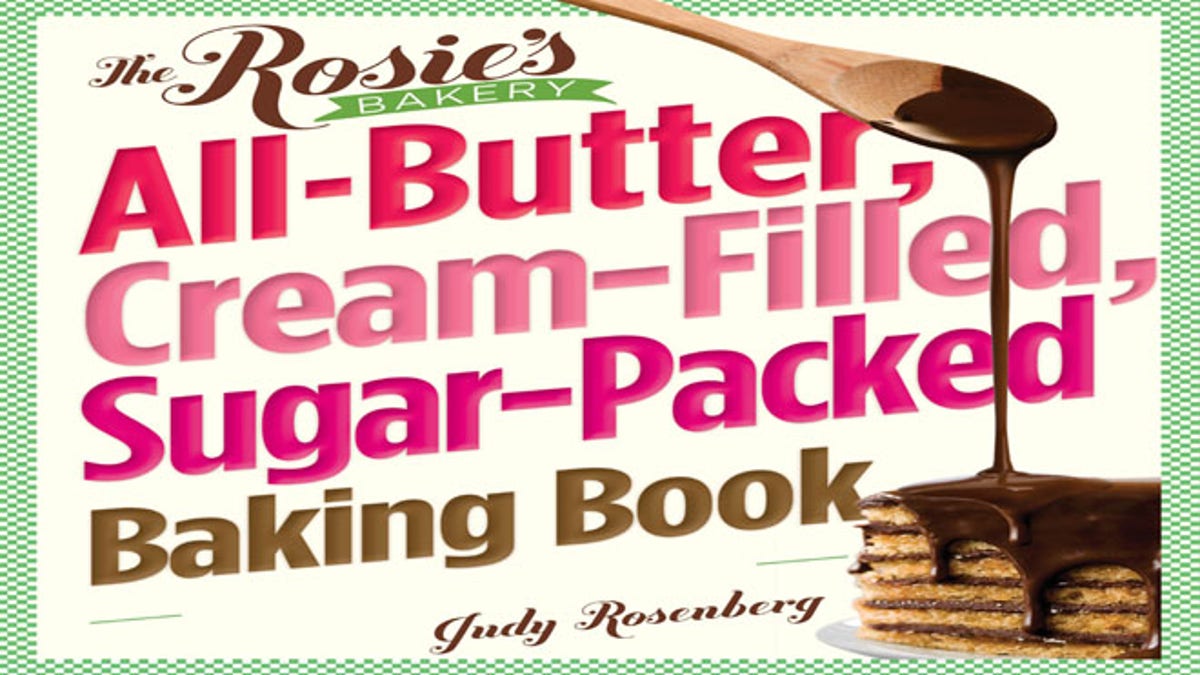
The Rosie’s Bakery All-Butter, Cream-Filled, Sugar-Packed Baking Book by Judy Rosenberg shows you may lose the things you crave most by substituting. (Workman)
Substitutes generally disappoint in head-to-head food comparisons: sugar vs. stevia (sweetener derived from South American perennial shrubs); steak vs. tempeh (a slightly-fermented soybean and grain patty); Parmesan cheese vs. “nutritional yeast.”
Allergies and health conditions obviously require substitutions, but low-fat, no-fat, low-sugar, no-sugar, dairy-free are becoming the rule and not the exception -- and that’s a bit sad.
It’d be nice to return to a time when we weren’t hectored about how “healthy” our food is, when eating made you feel good, not guilty. I can’t imagine my grandparents feeling guilt about eating warm crusty bread with fresh butter, just-out-of-the-oven chocolate chip cookies or butter-dipped cream biscuits.
Food has changed since then and the ubiquitousness of process food has added to a health crisis. Our times demand “healthy” alternatives.
When it comes to cooking I’m all for them as long as taste, texture and quality remain unchanged. It’s easier to reduce sugar and fat when cooking—you taste as you go along—but baking depends on chemical reactions inside an oven.
I wanted to find out if baking with substitutes could still yield the real deal.
It depends on the properties of the original ingredient, says pastry chef, Tish Boyle, author of Plating for Gold: A Decade of Dessert Recipes from the World and National Pastry Team Championships (Wiley).
Sugar
Besides sweetness, sugar imparts color to crusts, adds body and texture. It retains moisture, which prolongs freshness, and helps activate yeast in bread, brioche and croissants. But you can get some good results if you decide to swap it out.
A Splenda- Sugar blend of half-sugar, half-Splenda, does a good job, says Boyle. (Other sugar substitutes are a lot sweeter so avoid one-to-one substitutions and check labels.) A Splenda-brown sugar blend adds texture to crusts, scones, biscuits and cookies when sprinkled on before baking, just like turbinado (i.e. raw) sugar.
Milk
Fat content in soy and almond milk means it can replace cow’s milk, says Boyle. They work in baked items, like cake and muffins where milk is not the focal flavor point. It does work so much in puddings or pastry cream.
Fat
Fat substitutes, usually pureed fruits (apple, fruit, banana) often mixed with oil, are less successful, says Boyle.
Fat contributes to texture and mouth-feel in baking. It creates volume by trapping air bubbles in batter. It tenderizes cake by shortening the gluten strands, creating a tender crumb texture. (Longer, developed gluten strands produces a denser texture, like bread.)
“Baking relies inherently on fat to be good,” says Boyle. Fat’s a great thing in moderation and essential to good nutrition, she says. It’s when you eat an entire chocolate layer cake in one sitting that things go wrong.
Rosie’s Bakery’s Judy Rosenberg goes further. Reduce or remove the fat and you may as well not eat it, says the founder of the Boston-area chain. You lose all the things you crave when you do, she explains. Injecting a “dose of indulgence” that “makes you happy” is a necessity. “A state of deprivation is not healthy,” says Rosenberg.”
She spent a lifetime counting calories: “I can’t say for sure that I came out of the womb on a diet, but it certainly wasn’t long afterward that I was put on one,” she writes in The Rosie’s Bakery All-Butter, Cream-Filled, Sugar-Packed Baking Book (Workman). (She once invented a diet consisting of a Milky Way for breakfast, a brownie for lunch and a slice of apple pie for dinner. She lost twelve pounds.)
Since the market demands it she’s making a “healthier” cookie. Her “healthy” chocolate chip cookie won’t cut the fat, though. It’ll be made with olive oil, organic whole grain wheat flour, organic cane sugar, organic chocolate and other expensive ingredients.
“I’m famous for my chocolate chip cookies,” she explains. The olive oil ones have to taste exactly like her regular chocolate chip cookies—“I’ll get them to taste fantastic or I won’t sell them at all,” says Rosenberg. Ditto with the gluten-free chocolate chip cookies she’s developing.
Gluten-free is a “health” choice, she says, and “every baker should do it.” In addition to helping people with celiac disease and gluten-intolerances, there’s evidence that gluten-free diets benefit children with autism, she says. That’s why she offers gluten-free oatmeal chocolate chip cookies and other gluten-free desserts.
Manufacturers have done a terrific job of creating low-fat, no-fat, sugar-free versions that provide otherwise unobtainable treats for those with health and dietary restrictions. But for the rest of us, they fool only the eye, not the body or brain.
Eat real treats, just eat less. Substitute prune puree and oil for butter and you lose what Rosenberg calls “the orgasmic nature of that treat.” And end up profoundly unsatisfied.
